Previously, a consultation with a doctor meant a visit to the hospital, there was no other way. However, things have changed in the last few years. Since 2019, we’ve seen an active development of the telemedicine and remote medical services market. All this is possible thanks to innovative technologies and the Internet of Things (IoT for short).
Using the Internet of Things for healthcare, we replace part of the visits to the physician with an online consultation. Moreover, some medical tests can be performed remotely either, right at the patient's home. Why go to the hospital without special necessity and put yourself at risk of infection? Especially now, in the era of a pandemic, when the service sector goes digital.
Other benefits of IoT in healthcare include improved diagnostic accuracy and better patient care. Not so bad, right?
If you’re still in doubt, here are a few more facts you may find inspiring: the research company Gartner recently conducted a study and found out that in less than 10 years, medical companies that have implemented IoT technologies will be 10-15% more successful than those that have failed to do the same. Do you want to join the percentage of market leaders? Then you should read the following piece and apply the tips we're giving to you.
What Is IoT in Healthcare?
The concept of the Internet of Things (also known as IoT) means a system based on the exchange of data between certain devices (things) equipped with built-in sensors and other tools. The external environment is, too, involved in this data exchange: for example, if the room becomes too warm (the temperature has risen), then the thermostat reacts in a certain way (say, it turns off the heating).
How the story begins…
The first, very crude version of the IoT appeared in the last year of the 20th century. That's when a computer network of objects with built-in communication technologies (via the Internet) was created. The idea was to automate the work of devices and exclude human participation whenever possible.
This was the Internet of Things in its initial, somewhat primitive form.
Much has happened since then, and IoT has penetrated almost all areas of our lives. Medicine hasn't escaped its influence either… There has been a total digital healthcare transformation, which has led to the emergence of the medical IoT term (IoMT).
But what is the Internet of Things for healthcare? Let's get a look…
What is IoMT?
IoMT also deals with smart, sensor-supplemented devices but they all belong to the medical area; their task is to monitor the state of the human body and its environment. These devices help to collect more information about the patient and treat him better.
Today, IoT-based healthcare services are no longer uncommon... Becoming really popular and accessible, they're being more often implemented in clinical processes. We explain it as follows:
- lower cost of computing power and data transmission systems;
- active development of cloud technologies;
- growth in the number of connected devices around the world;
- pandemic (Covid 19), which resulted in the need to move the interaction between the patient and the doctor to a remote mode (as far as possible, of course).
IoT in the healthcare market
- Statista's analysis shows that at least 200 million smart medical devices will have been installed globally by 2025.
- If we talk about specific areas of IoMT use, there is an increased interest in telemedicine solutions that allow doctors to remotely treat their patients (which is understandable against the background of a pandemic).
- Healthcare IoT devices & applications are being actively used in the USA, Canada, Japan, South Korea, and several European countries.
- The founder of the Medical Travel Market believes that the IoMT market will at least double in the coming years (see infographic below).

The target audience of IoMT
IoT healthcare applications and all kinds of smart devices are aimed at 3 user groups:
- Medical experts. Below, we detail what medical specialists receive after the implementation of IoT in the healthcare sector. In short, they get a tool to work cost-effectively and productively.
- Patients. Of course, the patients themselves benefit too:
- they have access to better medical services, whether it be diagnostics, treatment, or rehabilitation;
- patients can communicate with doctors remotely, thereby saving time on visiting the clinic (which also leads to cost savings);
- and finally, patients are now able to monitor various health indicators themselves, even without professional help.
- Medical institutions. IoT devices for healthcare provide hospitals and other similar institutions with the following:
- impeccable monitoring of patients;
- tracking medical equipment;
- collecting and analyzing data and providing them in real-time;
- effective asset management.
How Does the Internet of Things for Healthcare Work?
So, here is a brief IoMT operation principle (a very schematic one, but you’ll get the gist, which is the main thing, right?).
- First, we need to get data for further processing, which is what special sensors do. They access the required information from the human body and/or its environment. Also, the sensors are supplemented with hardware and software to collect, store, and transmit the received data.
- Of course, we also need channels to deal with this data and transfer it further down the chain, so to say. Typically, these channels are Bluetooth, Wi-Fi, or (less often) wired options. The obtained and initially processed information passes through the chosen channel and enters a local computer, whether it be a smartphone, tablet, or PC.
- At this stage, specially created software (healthcare IoT applications) comes into play. Its features include:
- full data processing and provision of information to the user (doctor or patient, depending on who the software is aimed at). The result may be the display of an ultrasound image on the screen;
- storing the received information locally (on a smartphone or tablet) and, if necessary, transferring it via Internet channels to the cloud storage (so that the data is constantly available).

Now it's time to take a step-by-step look at how the Internet of Things is transforming healthcare.
7 Benefits of IoT in Healthcare
- Cost-efficiency. Below, we write how to use IoT-based healthcare systems. And you’ll see that, among other things, they help clinics and other similar institutions better manage drug supplies and diagnose medical equipment on time to avoid major breakdowns leading to costly repairs. In addition, the need to hire staff is reduced too (part of the routine work can be performed by special healthcare IoT devices and software).
- say, patients with severe physiological conditions requiring constant monitoring can be tracked using IoT-driven non-invasive monitoring tools without the direct participation of a person (physician).
- Acceleration of all processes. If part of the work is being performed by automated systems (using healthcare IoT devices), all processes are accelerated at times. The clinic works more efficiently, which results in the next item on the list, namely…
- Maximum treatment efficiency. Doctors can now treat their patients faster, better, and the results are more encouraging too. After all, smart systems are able to collect and process the most complete information about the human body, as well as help medical specialists make considered decisions based on the very accurate data received.
- Less influence of the human factor. According to statistics, in the US, medical errors are among the top 3 causes of death (more than 250,000 per year). The figure is very high and worrisome... fortunately, this problem can be solved by the implementation of IoT in the healthcare sector.
- Remote treatment process. The Internet of Things for healthcare reduces the need for hospital visits. And if the patient's health condition isn’t too serious, he may well choose an online consultation instead of a real doctor's appointment. Believe us, smart devices and remote patient monitoring systems can do a lot, they are great helpers in tracking important health indicators.
- What's good about fewer in-person visits to the doctor's office? Firstly, it saves patients’ money and doctors' time. Secondly, it reduces the risk of infections (which is a must-have in the conditions of covid).
- Greater availability of medical care. Remote treatment is also an opportunity to provide qualified medical care even in the smallest towns and villages. If the patient has a WI-FI connection, he can discuss his health problem with the chosen specialist (and it doesn’t matter if he lives thousands of miles away).
- Smart hospital space. And of course, the description of the benefits of IoT in healthcare would be incomplete if we forget about the increased comfort of those who are in hospitals. So, in the New York hospital NYU Langone, patients use a special smart system named MyWall to order food, control the lighting in the ward, receive information about the medical experts working there, and more. In addition, smart technologies often include AI elements, allowing clinics and other similar institutions to understand and analyze the needs of clients and offer them the most necessary things.
How To Use Healthcare IoT Devices & Apps
First, let's define the types of IoMT devices. What are they like?
- Diagnostic IoMT devices. They are needed to help doctors make more accurate and correct diagnoses.
- Preventive smart devices. They are aimed at ensuring that users lead a healthy lifestyle and, if possible, avoid diseases altogether. We're talking about traditional well-known devices such as fitness trackers, scales capable of determining the percentage of body fat, and so on: being connected to the Internet of things, they can participate in the collection of big data and contribute to the evolution of preventive medicine.
- Treatment-focused devices. Relating to a higher level, they simplify and improve the treatment process. These include the following examples: an insulin pump, a smart "pillbox" to better control medication intake, and others.
- Rehabilitation IoMT devices. And finally, let's not forget about IoT devices for healthcare that speed up the recovery of patients after serious illnesses. Among other things, they greatly improve health monitoring in real-time.
And now we’ll discuss what medical services can be provided using the above devices.
Types of IoT-based healthcare services
- Smart monitoring patients through IoT devices. It is about better care for seriously ill patients who are in the hospital. The IoMT is able to track the patient's condition without involving the nursing staff (and it saves time and resources, which we mentioned in the Benefits of IoT in Healthcare section).
- A good example is SMI, which produces special sensors to prevent bedsores in critically ill patients. These sensors are able to measure and change the pressure on the mattress to avoid such complications as ulcers.
- Improved drug management. So many healthcare costs are related to the poor management of drug stocks. Fortunately, the Internet of Things can partially solve this problem and make medicine management more transparent and clear.
- Examples include RFID technology, which allows revealing all the information about a particular drug.
- Equipment diagnostics. Another item of expenditure is medical equipment, which breaks down at the most inopportune moment and leads to unforeseen costs. The situation can be corrected by implementing IoT in healthcare processes
- Here's another example: e-Alert from Philips. Its task is to monitor the condition of medical devices, predict possible breakdowns, and warn the clinic management about the need to replace certain parts and other things.
- Personal health monitoring. There are more and more innovative devices and applications focused on the individual user and helping him stay healthy. How about smart tablets with built-in sensors? Or software that allows people with chronic diseases to monitor their health status? We can name so many examples of this sort, and it's impossible to list them all now.
- By the way, it's not just about physical health. IoMT services can be useful for those who suffer from depression and other similar conditions. The principle of their work is based on analyzing the users’ answers to critical questions and tracking some indicators of their condition, whether it be a pulse, pressure, pupil movement, and so on. If there is any cause for concern, the system sends an alert.
- Telemedicine, which includes so much... In fact, the concept combines all of the above. The main thing is that instead of health workers, basic actions are being performed by various smart devices in conjunction with healthcare IoT applications. Telemedicine makes the following possible:
- collection and processing of data about each patient (and work with data begins even before the patient visits the doctor in person);
- online consultation on urgent issues;
- consultations on the doctor-doctor model (exchange of professional experience);
- drawing up a map of the patient's activity;
- providing emergency care in critical cases (such as strokes).
Examples of IoT Devices for Healthcare
- Wearable (external) medical devices. Their category includes both simple devices like smartwatches and more complex options (such as a temporal artery thermometer with synchronization with a smartphone). Also, among the examples are smart wardrobe items (automatic recognition of types of activity, measurement of heart rate and temperature, etc.).
- Implantable medical devices. They are needed by people with serious health problems. A good example is a pacemaker that works in conjunction with software. The system is capable of automatically calling the rescue service (if there is one needed).
- Stationary medical devices, used in clinics and hospitals. They allow doctors to focus on treating the patient by transferring some of the responsibilities to smart systems.
IoT healthcare applications
Devices alone are clearly not enough to set the entire Internet of Things system in motion. You also need special software. Its task is to collect and process information, store it, and provide it on request in the right form.

IoT in Healthcare Examples & Real-Life Cases
- Tracking the movements of patients and medical staff in the clinic. This is implemented at Florida Hospital Celebration Health with the help of special badges with sensors.
- Caretaker, a home gadget worn on the wrist. Its main task is to monitor the health of the patient after he is discharged from the hospital. Caretaker measures temperature, pressure, pulse, respiration rate, and other indicators of a person's physical condition. All received data is being sent to the user's smartphone. Also, the system informs the attending physician about the situation with his patient.
- The software is being successfully used at the Sinai Medical Center in New York.
- Glasses from Microsoft. The illustrious company Microsoft also couldn’t bear to keep away and joined the trend. In 2018, the corporation added its smart glasses to pre-existing healthcare IoT devices. Equipped with optical pulse sensors, they are able to measure blood pressure. All the user has to do to power the glasses is to wear them.
- Proteus Discover has launched sensor-enabled pills on the market. They come with a special patch, which is also supplemented with sensors. The task is to collect data on how the human body works from the inside, process it, and convert it into a usable form. After being analyzed, the information becomes available for viewing both by the patient himself and by his attending physician.
- The Kinsa smart thermometer, an American development, is another example of IoMT. The thermometer's sensors collect data on the patient's temperature and transmit the information via Bluetooth to a mobile application. The app stores the history of temperature readings and thus can assist in the detection of disease outbreaks. In the era of covid-19, such IoT healthcare applications matter a lot.
- AdhereTech has come up with another version of smart pills. More precisely, we're talking about a smart box in which you can store your medicines. The box reminds patients of the approaching time to take drugs. Moreover, special sensors record when the pill is taken out of the box, and if this doesn't happen, the system sends special sound signals to the patient's smartphone. And, of course, the data collected is being sent by the doctor who treats the user in question.
- Vonage Telemedicine APIs (USA). Let's also mention the Vonage APIs, designed to facilitate the implementation of IoT in healthcare. Medical institutions can use Vonage to organize an effective process of remote treatment of patients (using audio and video communication channels, smart head-mounted cameras, remote patient monitoring systems, and more).
- Inspiren, an American startup, has created an advanced IoMT ecosystem called iN. It provides patients with the most comfortable stay in the hospital. Also, the effectiveness of treatment increases significantly. iN is based on the most innovative technologies, including motion sensors, computer vision, analytics solutions, deep learning engines, and more.
Challenges & Risks of Healthcare IoT Applications
Digital healthcare transformation brings many benefits to the medical industry, the main of which we‘ve discussed. But there are also some risks… and you have to know about them in advance.

- Medical data security. The problem is very acute and relevant for the healthcare of the United States and Europe (and other countries). Medical information about patients is confidential, and data transmission via the Internet implies the risk of its leakage. You need to achieve high protection of patients' personal information, which can be done in the following ways (as an option):
- storage of information in encrypted form;
- providing different levels of access to data;
- implementation of multifactor protection methods.
- Too much information. Healthcare IoT applications inevitably deal with Big Data (that is, with an endless stream of information). And the data needs not only to be protected, as we just said. Data needs to be skillfully processed, and not all software can handle this (at least, so far).
- The conservatism of patients and doctors. Oddly enough, many people still react to innovations with distrust and aren't always ready to apply new treatment methods (especially if they're based on unfamiliar digital technologies). Therefore, the first priority is to create products that are understandable and easy to use.
- Complicated integrations. Most IoT-based healthcare systems require integrations with third-party platforms and various useful services to operate at full capacity. Alas, easier said than done. You see, there is no single IoMT standard just yet, and each smart device operates according to its own protocol... which, as you can imagine, complicates the integration process.
Future of IoT Healthcare Applications
According to Markets and Markets, the global IoMT market will continue to grow strongly, with a CAGR of 21%. And what are we to expect in this regard?
- Digital healthcare transformation will evolve along with cloud platforms. This will facilitate the implementation of IoMT in the business processes of medical institutions;
- More and more solutions will use elements of AI to make the process of diagnosis and treatment as efficient as possible;
- Custom IoT devices for healthcare will get smaller and cheaper every year. In doing so, they’ll be able to collect more data and process it better and faster.
The medicine of the future is going to focus on treating the patient with minimal human effort (i.e., bureaucracy is kept to a minimum). And if you, too, want to make a contribution to the IoMT industry, it's time to think about some specific steps and actions. What about IoMT software development? We're ready to help you!